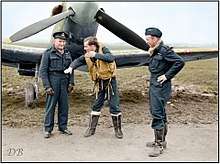John Pattison (RNZAF officer)
Squadron Leader John Gordon Pattison, DSO, DFC, Légion d'honneur (27 January 1917 – 11 September 2009) was a New Zealand fighter pilot and squadron commander of the Second World War. At the time of his death he was one of the few surviving New Zealand veterans of the Battle of Britain.[1]
John Gordon Pattison | |
|---|---|
 Pattison during World War II | |
| Nickname(s) | Johnnie |
| Born | 27 January 1917 Waipawa, New Zealand |
| Died | 11 September 2009 (aged 92) Hastings, New Zealand |
| Allegiance | New Zealand |
| Service/ | Royal New Zealand Air Force |
| Years of service | 1940-1945 |
| Rank | Squadron Leader |
| Unit | No. 266 Squadron RAF No. 92 Squadron RAF No. 485 (NZ) Squadron No. 66 Squadron RAF |
| Commands held | No. 485 (NZ) Squadron |
| Battles/wars | Second World War
|
| Awards | Distinguished Service Order Distinguished Flying Cross Légion d'honneur |
Early life
John Gordon Pattison was born 27 January 1917 in Waipawa and educated at Wanganui Collegiate School working on his father's farm. He joined the Civil Reserve of Pilots, and learned to fly at Hawke's Bay and East Coast Aero Club. With just 20 hours of flying time when the Second World War began, he volunteered for service with the RAF the day war was declared. He completed his training and sailed for the UK.
Second World War
Pattison arrived in Britain in late July 1940, attended 7 OTU and then joined No 266 Squadron based at Debden on 26 August 1940, flying Spitfires. On his first operation intercepting a force of enemy bombers he became separated from the squadron, ran out of fuel and made a wheels-up landing in a field. On 14 September he was posted to No 92 Squadron, based at Biggin Hill. On 23 September Pattison was attacked by a Bf 109 over Gravesend and received serious thigh wounds from a cannon shell, crash-landing at West Malling airfield. He spent eight months in hospital, but recovered and rejoined the squadron in June 1941 before becoming an instructor at 61 OTU a month later. In June 1941 Pattison contravened standing orders regarding low flying and flew under the Severn railway bridge and he lost three months seniority as a penalty.

In April 1942 he returned to operations with No 485 (NZ) Squadron, based at Kenley. On 26 April his Squadron was attacked by Focke-Wulf 190s, with four aircraft hit, two pilots were lost. The engine of Pattison's Spitfire was damaged, bailing out off the Sussex coast and rescued by an air-sea rescue launch.
Over the next year he flew on numerous operations and was rested in June 1943. In July 1943 he was awarded a DFC for his "determination, zeal and courage".
After a tour as chief flying instructor at 56 OTU, Pattison returned to operations in March 1944 with No 66 Squadron. He was involved in the Invasion of Normandy. On 6 July 6, 1944 he attacked a Messerschmitt Bf 109 near Chartres forcing the German pilot to bail out. A month later he shot down a Focke-Wulf 190 near Montrichard.
Pattison was appointed to return to and command No 485 (NZ) in September and he led in support of the advancing armies through France, Belgium and Holland, claiming many enemy ground vehicles destroyed. When No 485 was withdrawn from the front line in February 1945 Pattison was posted to the staff at HQ, 84 Group.
On 20 March he was awarded the DSO, the citation concluding that "he has set the highest standard of skill and courage and shown the finest qualities of leadership both in the air and on the ground".
By the end of the war, in at least 259 operational sorties, he had been credited with two enemy aircraft destroyed along with an unspecified number of ground vehicles.[2] He was shot down twice during the war.[3][4]
Discharged from the RAF in January 1946, Pattison returned to New Zealand to farm at Waipawa before retiring to Havelock North.
Honours and awards
Pattison was awarded the Distinguished Flying Cross in 1943,[5] and made a companion of the Distinguished Service Order in 1945.[2] He was awarded the Légion d'Honneur at the time of sixtieth anniversary commemorations of the Normandy landings in 2004. The award was personally bestowed by the nation's then-president Jacques Chirac.[6]
- 8 May 1945 - Acting Squadron Leader John Gordon Pattison DFC, (NZ.39931), RNZAF, 485 (NZ) Sqn is awarded the Distinguished Service Order in recognition of gallantry and devotion to duty in the execution of air operations:
This officer has completed a third tour of operational duty. He has displayed the highest standard of skill and courage and throughout his devotion to duty has been unfailing. He has shown the finest qualities of leadership both in the air and on the ground and his sterling work had contributed in good measure to the success of the squadron he commands. Within recent months, Squadron Leader Pattison has destroyed very many enemy mechanical vehicles and shot down 2 enemy aircraft.
— London Gazette #37070[2]
References
- "NZ Battle of Britain veteran John Pattison dies". New Zealand Press Association. Stuff.co.nz. 14 September 2009. Retrieved 20 September 2009.
- "No. 37070". The London Gazette (Supplement). 4 May 1945. p. 2415.
- "Kiwi Battle of Britain squadron leader dies". The New Zealand Herald. NZPA. 14 September 2009. Retrieved 7 October 2011.
- Battle of Britain pilot dies in hospital at 92
- "No. 36108". The London Gazette (Supplement). 23 July 1943. p. 3383.
- "France to honour NZ pilot". New Zealand Press Assn. 7 June 2004. Retrieved 20 September 2009.